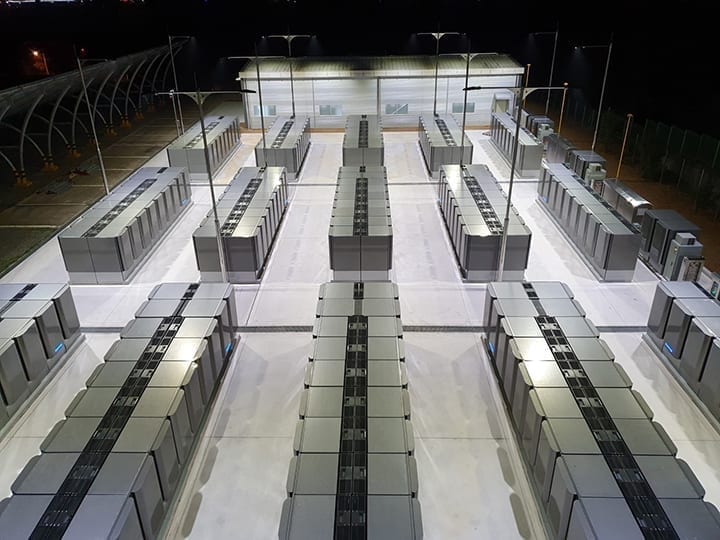New Fuel Cell Power Plants Deployed in South Korea and California
The post New Fuel Cell Power Plants Deployed in South Korea and California appeared first on POWER Magazine.

Two new fuel cell-based electricity generation facilities have been powered on" in the Gyeonggi province of South Korea. The new installations use Bloom Energy's solid-oxide fuel cells.
One of the power plants-a 19.8-MW installation-is located in Hwasung. It is the largest Bloom Energy project in South Korea, and the company's second-largest in the world. The other plant is in Paju. It is an 8.1-MW facility that Bloom Energy says will power nearly 18,000 homes in South Korea.
 1. Bloom Energy and SK Engineering and Construction have powered on two new clean energy facilities with fuel cell technology, including this one in Paju, South Korea. Courtesy: Business WireHow Solid-Oxide Fuel Cells Work
1. Bloom Energy and SK Engineering and Construction have powered on two new clean energy facilities with fuel cell technology, including this one in Paju, South Korea. Courtesy: Business WireHow Solid-Oxide Fuel Cells WorkAccording to Bloom Energy, its servers" convert fuel into electricity through an electrochemical process, without combustion, at the highest efficiency of any power solution available in the world today. The scheme has a modular design-any number of systems can be clustered together in various configurations to form solutions from hundreds of kilowatts to tens of megawatts.
Solid-oxide fuel cells consist of three parts: an electrolyte, an anode electrode, and a cathode electrode. The electrolyte is what the electrical ions move through in a fuel cell. For a solid-oxide fuel cell, the electrolyte is a solid ceramic material. The anode and cathode are made from special inks that coat the electrolyte. Unlike other types of fuel cells, no precious metals, corrosive acids, or molten materials are required in the Bloom Energy design. An electrochemical reaction converts fuel and air into electricity without combustion.
The system operates at high temperatures. Warmed air enters the cathode side of the fuel cell. Meanwhile, steam mixes with fuel entering the anode side to produce reformed fuel. As the reformed fuel crosses the anode, it attracts oxygen ions from the cathode. The oxygen ions combine with the reformed fuel to produce electricity, water, and small amounts of carbon dioxide. The water gets recycled to produce the steam needed to reform the fuel. The process also generates the heat required to keep the fuel cell warm and drive the reforming reaction process. As long as fuel and air are added, the process continues producing energy. Bloom Energy says its platform is among the most efficient energy generators in the world, and dramatically reduces electricity costs and greenhouse gas (GHG) emissions.
South Korea Is an Early Adopter of Fuel Cell TechnologySouth Korea is a leader and global champion of fuel cell technology for utility-scale power generation. According to some estimates, its six power generation companies have deployed about 300 MW of fuel cell power to date. In August, the largest industrial hydrogen fuel cell power plant in the world and the first to use only hydrogen recycled from petrochemical manufacturing was placed in service by Hanwha Energy at its Daesan Industrial Complex in Seosan.
South Korea has introduced several initiatives to increase power generation from renewable and new technologies. The government released a Hydrogen Economy Roadmap in 2019, calling for 15 GW of stationary fuel cells by 2040. The country's renewable portfolio standard incentivizes generation companies to increase renewable and new technology derived power to 10% by 2023. The energy initiatives are said to not only promote energy innovation, but also provide cleaner solutions and GHG emission reductions.
Maximizing efficiency is important for South Korea because it imports all of the natural gas it uses. Additionally, the terrain and population density of South Korea make a small footprint and modularly a practical energy solution for the country.
South Korea is clearly on the leading-edge of our world's energy future," K.R. Sridhar, founder, chairman, and CEO of Bloom Energy, said in a statement. And, this utility-scale deployment of fuel cells is a powerful proof point of its ambitious energy plan." Although South Korea was heavily impacted by the COVID-19 pandemic, the plants were able to be constructed and completed as planned.
We must all be thinking about how to provide the energy needed today while also contributing to the betterment of our air and environment," said Jason Ahn, president and CEO of SK Engineering and Construction (SK E&C), which was also heavily involved in the South Korean projects.
Fuel Cell Servers Also Added in CaliforniaIn July, Bloom Energy announced Southern California Gas Co. (SoCalGas) had begun powering two of its largest Los Angeles-area facilities with solid-oxide fuel cells. The switch to fuel cells was expected to provide electricity for the company independent of the power grid.
The SoCalGas pipeline system is integral to many Bloom Energy Servers installed in central and southern California, so we were eager to team up again to bring fuel cells to SoCalGas' own facilities," Kris Kim, managing director of strategic development at Bloom Energy, said in a statement at the time. Fuel cells at utility-owned sites are a natural fit as we are both looking to the future of energy and prioritize qualities like fuel flexibility, emissions reductions, efficiency, and reliability."
Furthermore, Bloom Energy intends to expand its commercial offerings. The company said it plans to enter the commercial hydrogen market by introducing hydrogen-powered fuel cells and electrolyzers that produce renewable hydrogen. These products will be first introduced to the South Korean market in 2021 through an expanded partnership with SK E&C.
-Aaron Larson is POWER's executive editor (@AaronL_Power, @POWERmagazine).
The post New Fuel Cell Power Plants Deployed in South Korea and California appeared first on POWER Magazine.